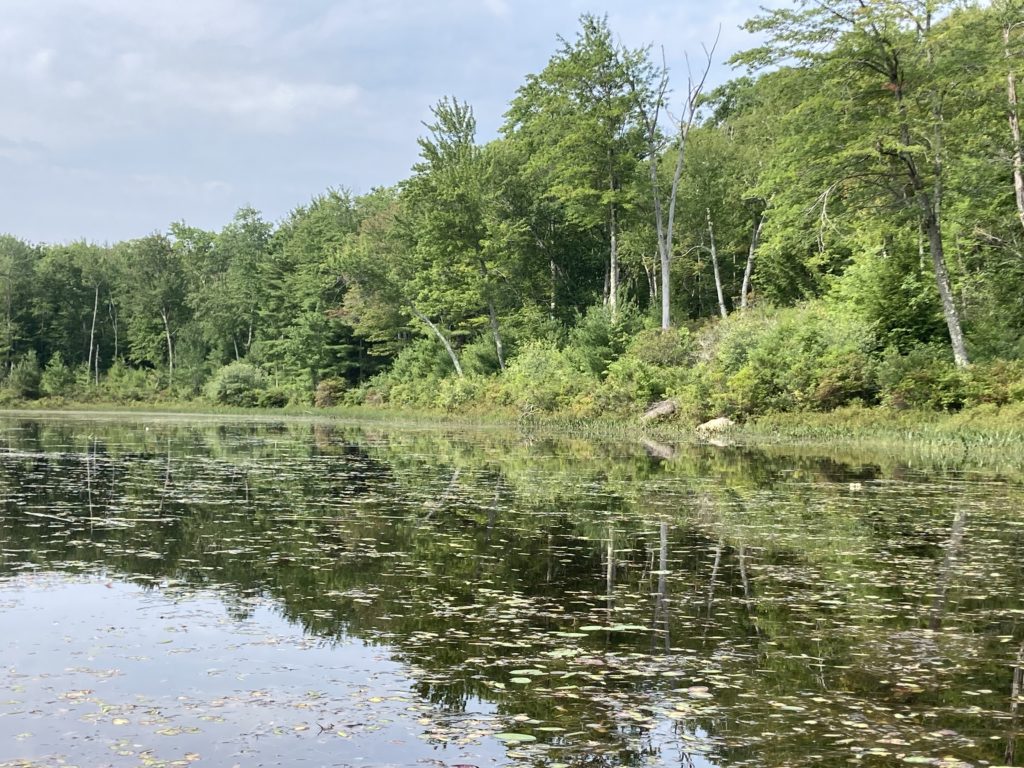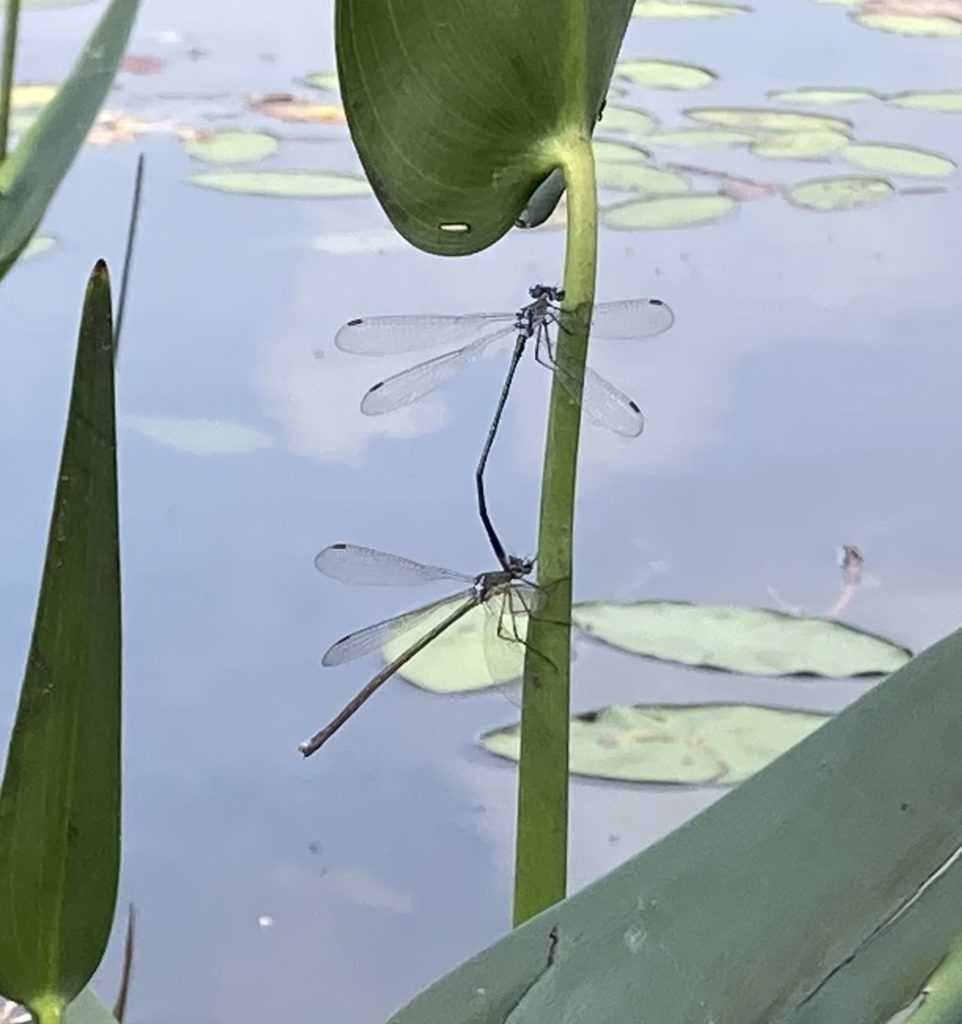Almanac: Spreadwings

Wicket Pond. Photo: Stephen Braun
One of the things I love about living in the Pioneer Valley is how quickly you can get to natural areas that give you the feeling of being in a distant wilderness. One of these areas is Wickett Pond in Wendell State Forest. Wickett is a lovely little body of water surrounded by forest. Birdsong, insect buzz, and the occasional leaping fish are usually the loudest things you hear.
Last weekend a friend and I spent several hours languidly paddling around the pond, drifting past large beaver houses, a stately great blue heron stalking a meal by the shore, and turtles basking on logs. But the real delights were at least a dozen species of dragon flies and damsel flies performing their astonishing aerial maneuvers as they hunted. These beautiful creatures are difficult to identify because they so seldom sit still or perch close enough for you to get a good look. But you can, at least, easily determine if you’re seeing a dragon fly or a damsel fly by the way they hold their wings when they alight: dragon flies hold their generally broad wings straight out to the sides of their bodies like airplanes, while damsel flies fold their thinner, smaller wings daintily behind them, alongside their bodies.
That, anyway, was the rule of thumb I’ve been following for decades. But during our paddle, I observed what seemed like damselflies by their size, shape, and flying behavior, but they did not fold their wings all the way back—they were held in a kind of half-way position I’d never seen before. After the paddle I consulted my field guide and learned about a family of damselflies called “spreadwings.” There are 18 species of spreadwings in North America and they generally have clear, delicate wings, wide-spaced eyes, and metallic-looking bodies (especially the males).

Most of the spreadwings we saw were either flying or perching in pairs. It looked like the tail of the front partner was attached to the head of the rear partner, which seemed like a highly implausible way to copulate if that’s what they were doing. “Maybe it’s damselfly cunnilingus,” my friend suggested. All of the tandem pairs we saw seemed to want their privacy—we couldn’t get closer than six feet or so before they flew off, so it was as reasonable a hypothesis as any.
The truth turns out to be more interesting than either of our simplistic theories. We were lucky enough to witness the spreadwings engaged in the final stage of a complicated mating and egg-laying process that occurs only briefly during any given year.
Male dragon and damsel flies have interesting genitalia. Most male insects have a genital opening and sperm-making machinery at the ninth, or next-to-last, abdominal segment. But, for reasons best known to Darwin, male dragon and damsel flies have another genital opening on the second abdominal segment, close to their legs. This second opening is well-positioned for joining with the similarly-placed female genitalia, but that would be a sterile coupling unless the sperm at the tail end of the body gets moved to the more up-front genital opening.
This requires some contortionist self-penetration by the males: they have to bend their long abdomens nearly in half in order to transfer sperm from the end of their abdomen and insert it into the secondary site. In dragonflies this pre-sex preparation happens before a female is found, but male damselflies, including spreadwings, wait until they actually have a female in hand, so to speak.
Sex for damselflies and dragonflies usually starts with the male grabbing the female just behind her head with specially-designed pincers at the tail end of his abdomen. Amazingly, both partners can fly perfectly well even while locked together like this, and the happy couple spends anywhere from a few seconds to several minutes flying around looking for a place to settle. (Some species of dragon flies manage in-flight copulation, but that’s another story.)
Once a pair of damsel flies finds a suitable spot, they maneuver themselves to line up their genitals even while connected head-to-tail. This creates something called a “mating wheel,” also called, rather romantically, a “heart wheel” because the pair of bodies forms a heart-shaped loop. The female curls her abdomen forward to allow penetration by the male’s mating organ, which is part of the secondary genital opening.
The transfer of sperm takes as little as three seconds to over an hour, but usually involves at least some degree of an initial pumping action by the male that expels any sperm that might have been deposited in the female’s oviduct by a previous male. The details are really quite stunning and have only been discovered relatively recently. With the oviduct nicely flushed, the male then injects his sperm, which will fertilize the female’s eggs unless she’s intercepted by yet another male.
It’s for this reason that male damselflies usually stick around after sex—literally. The pair un-lock from the “wheel” position, but the male usually keeps a fierce grip on the female while she flies around looking for a good spot to deposit her eggs. This is likely the tandem position my friend and I observed at the pond, with the male in front of the female. Which partner gets to decide where to fly, I have no clue, but it’s likely that the female is directing the flight and the male, even though he’s in front, is just along for the ride because she’s the one who knows what type of plant is suitable for her eggs.
When the right plant is found (typically the stem or leaf of a plant growing in water) the female makes a slit in the tissue and uses her ovipositor to inject her now-fertilized eggs. The male stays attached through this process, and sometimes even afterwards, to guard his genetic investment. At this time of year the eggs start developing immediately and, after anywhere from one to eight weeks, larvae emerge, drop into the water, and begin a larval stage of growth that can last anywhere from a month to five years.
After multiple rounds of growth and shedding of too-small exoskeletons, the larvae go through a nearly complete metamorphosis, acquiring wings and an entirely new body. The mature dragon or damsel fly then emerges from the last larval exoskeleton, spends some time letting their body harden, and then take to the air.
In general, adults live only two to four weeks. All the adults we saw, in other words, are either already dead or soon will be, which seems like a pity for creatures as sophisticated, beautiful, and perfectly adapted as these are. As you can tell by the many anthropomorphic liberties I have taken with this column, I’ve got a sentimental streak not shared by Mother Nature.
The brevity of an adult damsel fly’s life is counterbalanced by the extraordinary longevity of the species as a whole. Dragon and damsel flies have been gracing marshy parts of the earth for about 250 million years. They flitted around the dinosaurs, but managed to survive the cataclysm that wiped out those creatures about 66 million years ago. Compared to damsel flies, our own species has barely existed. Homo sapiens, emerged from earlier members of the genus only about 300,000 years ago. Humans have a very long way to go before we come anywhere close to the species longevity of the humble damsel fly.
Almanac is a regular Indy column of observations, musings, and occasional harangues related to the woods, waters, mountains, and skies of the Pioneer Valley. Please feel free to comment on posts and add your own experiences or observations.

A brilliant piece about my favorite paddle (et cetera 😉 pond too!!
Might it also be a reasonable hypothesis to conclude from the alternate ways of writing the names of these genera — “dragon flies” or “dragonflies” and “damselflies” or “damsel flies” — that the writer (or editor) is subtly reminding the reader about the various playful possibilities for linguistic copulation?
Ha! That would be the kind of clever wordplay that Douglas Hofstadter would employ. I’m not nearly so clever, but I’m grateful for readers who are so kindly intelligent that they come up with wonderfully inventive explanations for my inattention! Glad you enjoyed the piece, Rob.
P.S. I almost called Wickett’s Pond “my favorite paddle … puddle,” but that wouldn’t do this hidden natural wonder justice. The geology there is also quite interesting, especially the huge flat rocks at the pond’s southern end. About a decade ago, many trees on the east side of the pond came down: it may have been a combination of tornado and intentional forest management, and that opened up many boggy areas along the shoreline to more sunlight, leading more photosynthesis by some unmentionable (I don’t want to cause a stampede) bog bushes of water and carbon-dioxide into my favorite edible….